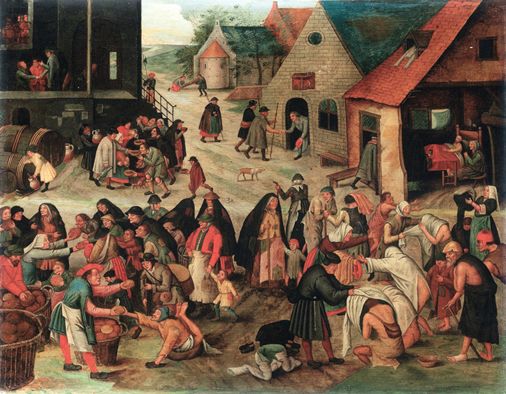School of Le Marche
The Tomb of Pope Gregory XII
1417
Sculpture, painting on stucco
275.0 x 232.0 x 53.0 cm
Co-Cathedral of St. Flavian, Recanati, Province of Macerata
School of Le Marche
Pope Gregory XII
17th century
Fresco
Diameter 105 cm
Co-Cathedral of St. Flavian, Recanati, Province of Macerata
School of Le Marche
Tablet commemorating Pope Gregory XII
1793
Engraved black marble
60.0 x 91.0 x 11.0 cm
Co-Cathedral of St. Flavian, Recanati, Province of Macerata
The inscription on the tomb reads:
"MAXIM. EC. PRINCEPS SUMQ. MONARCHA/ ORDINE GREGORI BISSENO CLAUDIT ARCHA/ HIC PR. PACE DATUS CELESTINOME SEMPER/ FERBUIT
ETHNEOS SUPERIS UNIR. DECENTE/ AST. BIS SCISM. MALU FCA HEC DEMTIA PISIS/ IPE PI. RELEVAT PURA ET CONSTANTIA TESTIS/ CARDINE BIS SACRO PASTORIS COSCIA TED./ MAR(C)HIA SUSCEPIT RACANAT. FLAVI. EDE/ SUB ANNO DNI MCCCCXVII"
The inscription on the tablet reads:
"GREGORIUS XII P. O. M. / VIR SANCTUS A D. ANTONINO DICTUS/ ET PROPTER SUMMAM IN ADVERSIS CONSTANTIAM/ S. STEPHANO MARTYR I COMPARATUS/ RECINETI XV KAL. NOV. AN. MCCCCXVII DEFUNCTUS/
ET IN HAC PRINCIPE ECCLESIA TUMULATUS/ ANGELI EPISCOPI A SE CARDINALIS RENUNCIATI/ ACCIPIENS DIGNIOREM LOCUM/ SOLEMNI E
MORTUALI RITU RENOVATO/ TRANSLATUS EST TERTIO/ CURANTE CAPITULO OB NOVI SACELLI/ PRO INSIGNIBUS RELIQUIIS A GREGORIO ETIAM/ ELARGITIS ASSERVANDIS DEDICATIONEM/ DIE XVIII JUL. AN. MDCCXCIII"
As we all know by now, thanks to the press, Pope Gregory XII (c. 1326 – 18 October 1417),was Pope from 1406 to 1415.
It was Gregory`s claim which was the only true claim
After his abdication Gregory`s cardinals that had been created by him were accepted as cardinals, and he was appointed Bishop of Porto and perpetual legate at Ancona.
He did not live to see the election of his successor Martin V, one of his cardinals
He was buried in what was then a new Cathedral. His tomb has been moved several times in the cathedral.
Of this period the German Lutheran historian Ferdinand Gregorovius (January 19, 1821 – May 1, 1891) wrote:
"A temporal kingdom would have succumbed thereto; but the organization of the spiritual kingdom was so wonderful, the ideal of the papacy so indestructible, that this, the most serious of schisms, served only to demonstrate its indivisibility" (Geschichte der Stadt Rom im Mittelalter, (History of Rome in the Middle Ages), VI, 620).
It is in Recanati in that small forgotten area of Le Marche we can still see how one man`s act of sacrifice was a tool for the revival of the Church in a way never at all contemplated when he made his historic act.













